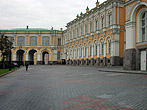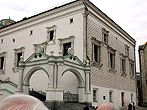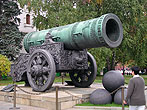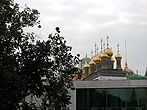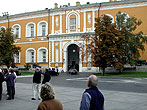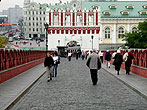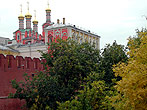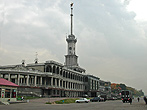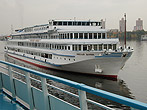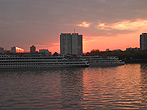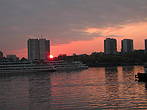The Kremlin
September 27, 2005
The Kremlin is Moscow's central architectural ensemble. It is located on the high bank of the Moscow River and dates back to the 11th Century. In the earliest days, it was surrounded by a moat with ramparts. It was much smaller than in its present configuration. Following the growth of the city and government, it was reconstructed several times. The towers, 22 in total number, and the Armory, Great Kremlin Palace and Arsenal all date from the 18th and 19th centuries.
The walls surrounding the Kremlin have an overall length just short of 1.5 miles. These walls are from 16 to 62 feet high and are 11 to 21 feet thick. The towers originally were topped with flat platforms for accurate aiming of weapons of the day. In the 17th century the tall hipped roofs were added. The height of the towers vary from 92 to 233 feet. The Saviour and Trinity Towers being the tallest.
The Great Kremlin Palace is similar in architecture to the Armory. This first photo was taken through the steel bars of the gate. The gold domes are on the Cathedral of the Annunciation. It was built between 1845 and 1849. It is unfortunate that we did not have time to go inside this Cathedral. A book on Moscow that we purchased shows that it has a beautiful interior.
The previous photos were taken while we stood in line to enter the Cathedral of the Archangel Michael. Once inside the chandelier was overwhelming as well as the frescoes. This Cathedral is small and was extremely crowded with visitors.
This building with the geometric finish on the wall is call the Faceted Palace. An interesting wall treatment. Having worked our way around the Faceted Palace and other buildings, we came upon the Tsar's Bell — a huge bell that broke before it was ever rung. This bell, nearly 200 long tons in weight, is one of the largest bells in the world. The section of it seen in the break is approximately 18 inches thick. The canon was made in 1586, a huge relic about 17.5 feet long and weighing 85,000 pounds with equally huge canon balls probably near 35 inches in diameter. It has never been fired but is a tribute to the workmanship of the gunsmith. Blocking part of the view in the lower foreground is a modern section of the State Kremlin Palace.
And finally of this group, in the background with numerous gold domes is the Church of the Deposition of the Robe. It was built between 1484 and 1486 and is in the style of early Moscow architecture.
We are finding our way to the pickup spot where our bus will arrive. This first building is the Arsenal commissioned in 1701 by Peter the Great to store weapons and military equipment. Peter ordered that the Arsenal be made into a museum display of military glory and encourage the collection of military paraphernalia from all over the country and that seized from foreign enemies during battle. Most of the Arsenal's collection is now housed in the Armory, apart from several canons that were captured during the Napoleonic Wars, and which are ranged along the front of the building.
These next few photographs were taken on the sloping walkway or drive leading out of the Kremlin. Ahead of us is the Kutafya tower. Looking behind us, is another church and a section of the Kremlin wall with its battlements. Troitskaya Tower as one of the tallest surrounding the Kremlin towered over us, no pun intended.
Taking our time, we checked the view through one of the battlements and Mieko posed for a photo. Waiting for our bus, we chatted with Natasha, our guide for the entire trip, before heading back to our boat.
Our boat was tied up at what appeared to have been built as a terminal for waterway traffic. This building has all the features of a building constructed during the 1930's. Strangely, from a distance it looks like a very larger steamer. Certainly, river transport of people and commerce was much more active 70 years ago. The boat is not our boat, but one of the 50 to 60 on the waterways that looked just like our boat. All the same design, same size and same color.
For our last night in Russia, we dined and watched the sunset. Our last activity would be a tour of Moscow at night, specifically for the purpose of photographing the sights.
